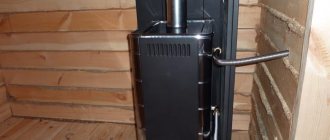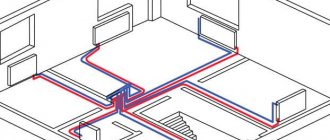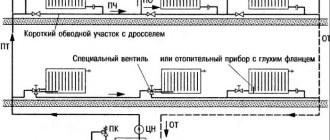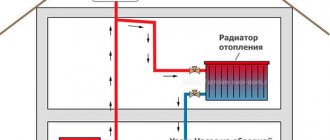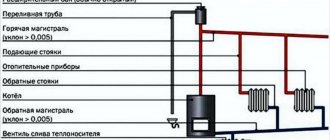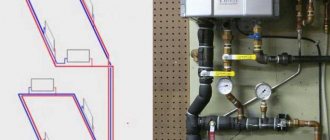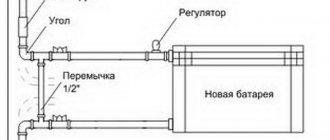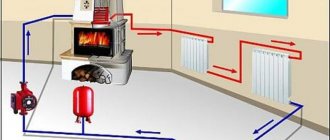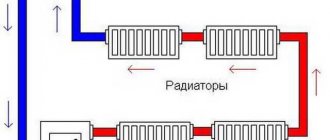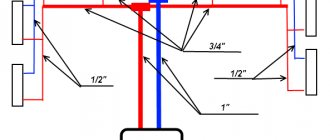What are water supply risers in an apartment building?
The vertical water supply system that delivers water from the main water supply of the house to the apartments (apartment inlet) is called water supply risers.
The risers are mounted in pairs and parallel. By paired gasket we mean the installation of hot and cold water supply (DHW and cold water supply). Parallel installation means that hot water and cold water are laid along parallel routes, usually in the bathroom. The distance between the DHW and cold water risers is from 250 mm.
For example, in the photo we see risers made of galvanized steel pipe with a welded connection.
risers made of galvanized steel pipe
Material for water pipes
Since water supply risers belong to the water supply system of an apartment building, any available water pipes are suitable for riser pipes. Namely,
- metal-polymer pipes (SP 40-103-98);
- galvanized steel water and gas pipes (GOST 3262-62),
- seamless steel cold/heat-drawn, cold/warm-rolled pipes (GOST 8733-66) with protective coatings against corrosion;
And also, according to SNIP 2.04.01-85:
- plastic pipes made of polyethylene, polypropylene, polyvinyl chloride, polybutylene;
- fiberglass pipe
- pipes made of other plastics.
In addition, pipes (according to SNIP 2.04.01-85) from:
- Copper, bronze and brass.
As you can see, according to the standards, water supply risers in an apartment building can be installed from any water pipes.
The same statement applies to replacing riser pipes (risers) in a single apartment.
How to shut off the heating riser and start it after repair
To repair risers, it is necessary to first reset the system, and after completion of the repair work, a restart is carried out. The implementation of these operations must occur according to a certain algorithm.
Bottom filling
First you need to find the appropriate valves. You can find them by focusing on the flights of stairs and the layout of heating devices. If necessary, you can go up to the top floor and see how the jumper is located. To discharge the risers, it is necessary to unscrew the plugs or open the relief valves. Having completed this work, you can close the discharges and very slowly fill the system with water. The slowness of this process is due to the fact that when the system is quickly filled, a water hammer can occur. If there are screw valves, the water must move in the direction indicated by the arrow on the body - otherwise the valve may break, after which you will have to reset the heating system in the entire house.
Then you can open the valves completely and relieve the air pressure on the upper floor. The Mayevsky valve is usually located in the radiator plug or in the upper part of the jumper. Resetting and starting will be greatly simplified if all valves installed in the system are ball valves.
Top filling
In this case, starting the heating is much easier, but resetting the system will require much more steps. First, the attic riser is blocked, and after that - installed in the basement. Now you can open the reset. To prevent a possible mistake when turning off the system in the attic, it is worth starting from the number of taps into the bottling from the located reference point. Having completed the work, you can close the discharge and very slowly fill the riser. It is imperative to observe the direction of water movement. Now you can open both valves. There is no need to bleed the air: it will move itself into the attic expansion tank.
Metal pipeline
This is a traditional heating material. The operating temperature of the carrier in apartments can reach 110 C. In practice, this is quite rare, but 75–95 C is a common occurrence. Metal copes with this task perfectly.
Stainless steel – combining water and iron is not considered a good idea. Metal is susceptible to corrosion, and therefore unusual steel is used for communication systems - stainless or galvanized. The material has a lot of advantages and some disadvantages.
- Steel is very durable. 50 years is the typical lifespan of the system.
- Stainless steel is not subject to corrosion. In addition to the fact that this ensures durability, this property also determines the relative smoothness of the internal walls: the working diameter changes less over time, since salt and sediment are deposited to a lesser extent.
- Steel products can withstand not only high temperatures, but also pressure surges, which often occurs in a city apartment.
- Installation of heating risers made of steel pipes requires welding. The main difficulty is that bent structures are not possible here.
- The steel is quite heavy, so the system itself is more difficult to maintain and its assembly is not easy.
Copper piping is the most expensive option available. There are many advantages to this.
- This system is the most durable and reliable.
- Complete chemical inertness - copper does not interact with salts, alkalis, or acids.
- The working diameter of the heating riser pipe does not change over time, since the copper walls remain completely smooth.
Copper is a very ductile metal, installation is done by soldering, and bent structures do not cause any particular difficulties. And since metal is very decorative, there is no need to disguise pipes made from it.
It is not recommended to use galvanized steel for heating: salts and various active additives added to hot water quickly destroy the zinc coating. And without protection, steel quickly deteriorates.
Plastic pipeline: polypropylene and metal-plastic
Not all plastic can be used. Thus, ordinary polyethylene cannot withstand not only high pressure, but also the average operating temperature of the carrier.
Cross-linked polyethylene is a relatively new material, the main advantage of which is its resistance to high temperatures - it can withstand 95 C.
- The material is not subject to any type of corrosion. Moreover, it is resistant even to direct sunlight, which is usually no different from plastic.
- Chemical inertness is characteristic of all polymers.
- The ideal smoothness of the walls ensures that the diameter remains unchanged - no sedimentation until the end of its service life.
Light weight - installation is very simple.
A heating riser made of polypropylene pipes is the most affordable design. Moreover, it has all the other advantages.
- The polypropylene structure is connected by welding to fittings. The seams here are no less durable than the material itself.
- Temperature resistance and chemical inertness are no less than that of cross-linked polyethylene.
- Resistance to water hammer.
- The disadvantages inherent in polypropylene products include a high coefficient of thermal expansion. When installing the system, it is necessary to provide compensation loops and non-rigid fastening.
Metal-plastic pipes for heating risers do not have this drawback. This is a multilayer product, the role of the middle layer in which is played by a thin aluminum sheet - solid or profiled. It not only provides the pipeline with additional strength, but also compensates for thermal expansion.
- Simpler installation - connection to fittings of the appropriate diameter and the absence of compensation devices.
- Chemical inertness and resistance to high temperatures.
- Thanks to the metal layer, oxygen does not destroy the walls; the metal-plastic riser is much more durable.
- The construction cost will be higher.
Heating system elements
Determining the right boiler
The boiler is the heart of the heating system
It is very important to choose it correctly, since the reliability of heat supply largely depends on it
Heating boilers can be used either singly or in pairs, for example, in addition to an electric boiler, a solid fuel boiler can be included in the circuit in case of a power outage
Depending on the fuel used in the boiler, the following types of these devices are distinguished:
- Gas. This boiler is most popular among consumers. It is easy to install and works without unnecessary noise. Gas is relatively inexpensive and produces a lot of heat when burned. But to use it, you need to obtain permission, order the installation of a supply line and organize exhaust ventilation in the boiler room.
- Electrical. These boilers are the safest. Their installation location does not require any additional equipment. Their operation does not produce open flames or combustion products that could cause poisoning. But the efficiency of this device is relatively low, electricity is expensive, and the energy-intensive boiler requires a reliable power grid.
- Liquid fuel. Unlike gas boilers, these boilers are equipped with a special type of burner. This equipment requires a special boiler room. Liquid fuel quickly pollutes the boiler.
- Solid fuel. These devices burn coal briquettes and other types of solid fuel. If you are ready to prepare firewood or coal for the entire cold season, then you can use this option.
Combination boilers are considered the most reliable, in which different types of fuel can be used. There is only one drawback to such equipment - such boilers are expensive.
What are heating radiators?
In order not to be disappointed with the results of the work performed, you need to take a responsible approach to the choice of radiators. In this case, you should focus not so much on aesthetic qualities, but on the technical characteristics of the batteries. And the technical properties largely depend on the material used to make these products.
Modern cast iron radiators can look very attractive, especially if the interior of the room as a whole is designed in the same style.
Radiators are:
- Steel. These inexpensive products are too susceptible to corrosion. If the water is drained from the system in the summer when heating is not used, the service life of steel radiators can be significantly reduced.
- Aluminum. These attractive looking radiators heat up fairly quickly. Only significant pressure drops have a negative effect on them. In private homes this danger does not threaten them.
- Bimetallic. Such batteries are resistant to corrosion from aluminum, and high heat dissipation from steel.
- Cast iron. These products are expensive, but they will last a very long time. They take a long time to heat up, but they also take a long time to cool down. The significant weight of cast iron products is not a hindrance during their operation, but can slow down the installation process.
There are new models of radiators that have a protective coating applied to the inner surface. These batteries are a little more expensive, but the money spent on them is more than worth it.
How not to make a mistake with pipes
Installing a heating system will require a lot of pipes.
Which one should you prefer:
- Metal. The service life of such pipes is not very long. Over time, metal products can rust. They are mounted using threaded connections.
- Polymer. This is an inexpensive but fairly reliable material that is resistant to corrosion. Even a non-professional can install these pipes. A pipeline made of polymer pipes will last a very long time.
- Metal-plastic. These pipes contain aluminum and plastic. The pipeline from them is assembled using threaded or press connections. As a byproduct of the high coefficient of thermal expansion of these pipes, they can crack if the water temperature changes suddenly.
If the home owners have no budget restrictions, it makes sense to install heating systems using copper pipes. This is a very expensive material, but the costs are worth it. Such pipes are reliable and durable.
They tolerate increases in temperature and pressure well. For their installation, soldering is used - silver-containing high-temperature solder.
Everything we told you above concerned the radiator water supply. But water can also be used as a coolant in other heating systems.
When installing a water heating system, you may need quite a lot of pipes, so you need to calculate the feasibility of purchasing expensive products and focus on your real capabilities
Selecting the material for the heating riser
Heating from polypropylene
In the vast majority of cases, heating risers in an apartment building are made of steel pipes. After several decades of operation, their condition will be unsatisfactory. If the apartment is replacing pipes with new ones, you must also install a riser made of high-quality materials.
However, this may cause difficulties. The technical characteristics of the new pipe material must meet the requirements. You can learn about them from the technical conditions from the management company, or by consulting with their representatives by phone. Most often they are as follows:
- Correspondence of pipes to the temperature regime of heating operation . Those. the new design must withstand the maximum possible thermal impact without causing emergency situations;
- System pressure . For centralized heating it can range from 3 to 6 atm. But you need to remember that water hammer may occur periodically (when the system is filled). Therefore, a margin of 25-30% must be added to the normalized pressure value. This is why you cannot install a circulation pump on a heating riser;
- Ensuring proper thermal insulation of the pipe . This should only be done if it passes through a non-residential premises where exposure to negative temperatures is possible. For this purpose, thermal insulation of heating risers is done.
Soldering polypropylene pipes
Several classes of pipe materials meet these requirements. The easiest way is to install the same steel one. But most often the choice is made of polypropylene models.
To install a heating riser, it is best to choose a high-strength polypropylene pipe - PN25. It is designed for high maximum pressures. The problem may lie in the heating operating temperature. If the upper limit exceeds +90°C, installation of polypropylene is impossible. Then the only option remains steel pipes.
Under no circumstances should metal-plastic lines be installed. Despite good thermal insulation performance, heating risers made from them will be extremely unreliable. This is due to periodic pressure drops in the system. Gaps most often occur in connecting assemblies, which are made from clamp fittings.
After turning off the heating riser, before starting it for the first time, it is necessary to perform a pressure test. Only after this can coolant be supplied to the circuit.
What are pipes made of?
Pipes used in heating systems must withstand high temperatures and severe pressure surges. Several types of materials meet these requirements:
- steel;
- copper;
- metal-plastic;
- polypropylene;
- cross-linked polyethylene.
Each of the materials has its own advantages and disadvantages. Steel is durable, can withstand a coolant temperature of 95 degrees, but is expensive, wears out quickly, and is difficult to install. Copper is very expensive, but it lasts for several decades and is highly resistant to all negative influences.
When installing modern heating systems, metal pipes are used less and less. They were replaced by metal-plastic, polypropylene, and polyethylene. Synthetic materials are resistant to high temperatures, pressure and corrosion, have high thermal conductivity, and are well suited for hidden installation.
Cross-linked polyethylene is a new promising material on the construction market
Products made from cross-linked polyethylene attract special attention from buyers. This is an innovative material with which you can install an almost eternal heating system
It is not afraid of corrosion, pressure, or high temperatures. Pipes made from it are thin and light, but at the same time very durable.
The main advantage of cross-linked polyethylene is its high ductility: it can withstand high loads and quickly takes its original shape. Thanks to this property, pipes do not flow at the joints, which makes the material ideal for hidden installation. The only drawback is the high cost of the material itself, connecting elements and tools for installation.
Rules for connecting radiators to the riser
Methods for connecting a radiator to a riser
Replacing a riser is most often associated with a general modernization of the heating system. At the same time, not only new pipes are installed, but also radiators and batteries. It is important to choose the right scheme for connecting them to the heat supply system.
First, you need to equip the radiator so that it can effectively perform its functions. Its harness should include the following components:
- Shut-off valves . With its help, you can completely limit the flow of coolant into the battery for its repair or replacement;
- Thermostat . Necessary to reduce heat flow in order to reduce surface temperature;
- Mayevsky crane . Device for removing air pockets.
In addition to possible thermal insulation of heating risers, the layout of the supply lines is taken into account. For a one-pipe system, a bypass must be installed. This is a piece of pipe connecting the inlet and outlet pipes of the radiator. The diameter of the bypass should be one size smaller than that of the heating riser. In this case, the occurrence of a low pressure zone in the system can be avoided.
Experts recommend using identical pipes to connect the drain to the battery. This is necessary to normalize the operating parameters of the entire system, and will also significantly facilitate the complexity of installation. As an additional measure, pressure and temperature sensors can be installed. In this way, you can control the quality of the heating service.
To prevent premature battery clogging, it is recommended to install a strainer. It is mounted on the supply pipe in front of the thermostat.
Terminology
First, to avoid confusion, let's define the terms.
- An elevator or heating unit is a place where the control of the heating system and hot water supply of a house or part of it is concentrated.
In addition: the elevator unit brings the pressure and temperature of the coolant to optimal values for the operation of the heating system. Thus, the difference between the supply and return lines of the highway reaches 4 kgf/cm2, while at the same time, a difference of 0.2 kgf/cm2 is sufficient to circulate water through the batteries.
- The water-jet elevator is the main element of the elevator unit, a mixing chamber in which warmer supply water is mixed with the return water involved in repeated circulation.
- Suction is a pipe connecting the supply and return in the elevator unit. Through it, the colder water of the return pipeline enters the repeated circulation cycle.
- Bottling (bottling) is a horizontal pipe that supplies coolant from the elevator unit to the risers.
- Risers are vertical sections of the heating system that supply water specifically to heating devices.
- Connectors are pipes connecting the riser to the battery.
So, what specific wiring diagrams for heating systems can be used in multi-apartment buildings? What specific elements do they include?
Neighbors blocked the heating riser - what to do?
The heating riser is blocked
Despite the fact that heating repairs are best done outside of the heating season, some people do not adhere to this rule. What to do if the neighbors have blocked the heating riser and one of the heating circuits is not functioning?
There are many recommendations for resolving this issue - from general reprimand to calling the police. Ultimately, this will lead to the desired result - the air temperature in the rooms will be normal. However, such methods are not correct. If you suspect that your neighbors have blocked the heating riser, you need to do the following:
- Call the Management Company and make sure that no repair or maintenance work is currently being carried out in the house.
- There is no need to run around apartments and look for the reason for the shutdown. Representatives of the management company should be called to resolve this issue. It was with her that a contract was concluded for the supply of heat to the apartment.
- Once the culprit has been found, he can be threatened with a fine for unbalancing the heating system. This clause is mandatory in the heat supply contract.
Only with these methods can the heating be restored. All others require too much unnecessary effort and will also lead to loss of time and nerve cells. Everyone must fulfill their contractual obligations. This primarily concerns the management company.
In the video you can familiarize yourself with the features of replacing the heating riser:
Preliminary actions
Even before all the necessary equipment, pipes and elements for them are purchased, it is necessary to legalize the change of the riser in the apartment, if it is not planned.
To do this you need:
- Submit an application for replacement of heating pipes to the housing office long before the start of the heating season (be sure to indicate why replacement is required).
- Then the application will “migrate” to the organization of the heating network.
- An employee of the management company is obliged to come and check the validity of the request to replace the riser. If it is caused by an emergency condition of the pipes, then all costs for dismantling the old system and installing a new one are borne by the organization. In the event that residents decide to replace old risers with new ones in order to reduce heat loss (this reason is considered valid), then all work is paid for by the owner of the property.
- It is necessary to collect the signatures of neighbors who agree to such work , present them to the management company, and only after all permits have been received, begin to dismantle the old pipes.
If the heating risers in an apartment building are in emergency condition, then there is no need to collect signatures, since such a situation requires urgent intervention and repair.
As a rule, there are no prohibitions on unauthorized replacement of pipes in critical condition. Therefore, if the management delays the start of work, then in order to protect property, you can begin to dismantle and install new risers without permits, but only during the non-heating period.
Heating riser in an apartment building. Heating distribution. Plastic pipes for heating
A person who has become the new owner of a house is often faced with the problem of rusty and dilapidated pipes. It’s not surprising, because if the house has been in service for many years, then systems such as water supply, heating and sewerage have probably worn out significantly.
This is where other problems begin to appear. For example, a heating riser in an apartment building is a common property, for the replacement of which all residents must pay. And if the house is maintained by the housing department, and replacing the riser is urgent (for example, in the event of an accident), then the problem falls on the shoulders of the employees of this institution.
Features of replacing risers and heating pipes
To replace the heating riser, you need to perform the following steps in sequence:
- Shut off and drain the water.
- Using a grinder, cut out the old pipes and pull them out of the floor slabs.
- Decide on the location of the battery and install it using a level and a hammer drill.
Advice: before starting work, it is better to get permission from the neighbors living above and below, since if the heating riser in the ceilings remains the same, then the repair will lose its meaning.
System layout
It is important to remember that the installation must be carried out in accordance with the level, since misalignment inevitably leads to air accumulation and poor battery performance. It is not superfluous to purchase shut-off valves that allow you to shut off an area (for example, if there is a leak) without thereby disrupting the operation of the system as a whole.
If you plan to carry out installation work yourself, then the best option is metal-plastic pipes that can easily take any shape. Special threaded connections allow for fastening.
Heating installation requires the purchase of metal pipes (preferably stainless steel).
Drawing up a diagram
Installation work cannot begin without a detailed diagram. To do this, you need to decide on the type of heating, the type of system itself and the routes for laying the pipes.
Heating distribution can be two-pipe or single-pipe. The first option involves forward and reverse wiring. This will make it easier to regulate the temperature in the house. After completing the calculation of the number of pipes, their length and diameter, you can begin installation work.
Options for wiring diagrams for heating
If preference was given to a single-pipe vertical system, then the top floor or attic should be chosen as the location for the supply line. Thus, the vertical heating riser will be able to supply coolant to each heating device.
The advantage of this is the economical use of pipes, but the disadvantage is the impossibility of separately turning off the heating devices.
In the case of laying a two-pipe vertical heating system with bottom wiring, the supply and return lines should be laid directly along the floor or slightly above its surface. This allows each radiator to be provided with its own coolant. This choice leads to an increase in the length of the pipeline, but it allows you to regulate the heating and turn off the heating device at any time.
A horizontal two-pipe system involves laying a return and supply pipeline around the perimeter. Each heating device must be equipped with a special tap that allows air to be released from the structure. This scheme involves switching off heating on a floor-by-floor basis and using radiators with bottom connections.
The choice of a two-pipe floor-by-floor collector system involves the installation of a supply and return collector. During installation, plastic heating pipes are used.
Disabling the riser
How to properly turn off the heating riser? The lower spill assumes a pairwise connection. The simplest option for determining its location is to go up to the apartment located on the floor above and familiarize yourself with the location of the jumpers.
If the house has an overhead outlet, then turning off the heating riser involves closing one valve each in both the basement and the attic. How to determine where they are located? The main thing is to choose the right entrance, and calculating the position of the valve itself is simple. After closing both taps, you need to unscrew the plugs and open the dump valves. After complete drainage of water, check the serviceability of the shut-off valves. That's it, the heating risers in the apartment building are turned off!
Important! Carrying out work during the heating season is only possible if there is access to the apartment located at the very top. If no one lives in it, then it will be impossible to start heating.
The simplest way to disconnect a heating device is to cut the line to it. Then the lock nut is released, and the piece of liner is unscrewed from the radiator plug.
How to choose the right place to cut the riser? It all depends on the relationship with the neighbors living above and below. Practice shows that it is better to replace the heating riser through the ceilings, since destruction of pipes by corrosion is most often observed at points of contact with concrete.
Metal-plastic pipes
The modern market has a huge assortment, so the buyer only needs to decide which plastic heating pipes he wants to install.
Main types:
- metal-plastic;
- polypropylene;
- cross-linked polyethylene.
Positive characteristics of the former include:
- corrosion resistance, hence long service life;
- excellent permeability and constant diameter, since the formation of salt deposits is impossible;
- low level of roughness of the inner layer, which guarantees minimal coolant pressure loss;
- minimal linear expansion, and this is the most important indicator for heating, especially if there is hidden wiring;
- high frost resistance values.
Why do metal-plastic pipes have such high technical characteristics? It's all about the multilayer structure: polyethylene (2 layers), aluminum foil (1 layer) and adhesive (2 layers). In addition, metal-plastic pipes boast the following properties:
- The maximum operating temperature is 95°C.
- The operating pressure parameter at the above temperature is 10 atm.
- When the temperature drops to 25°C, the operating pressure increases to 25 atm.
- Exposure to temperatures up to 130°C is permitted for a short period of time.
Polypropylene pipes
The heating riser in an apartment is often connected to polypropylene pipes. They have many positive qualities. These include:
- affordable price;
- flexibility, allowing you to get any desired shape;
- long service life;
- good resistance to high temperatures;
- high thermal conductivity.
Pipes made of cross-linked polyethylene
The heating system riser can also be extended with a pipe made of cross-linked polyethylene, a material that is not susceptible to high temperature effects. Polyethylene itself is soft and plastic, which is incompatible with heating, but scientists were able to identify a method that turns it into a durable product.
Technical characteristics of cross-linked polyethylene:
- operating temperature maximum – 95°C;
- ability to withstand pressure up to 7 atm;
- lowering the temperature to 70°C increases the operating pressure to 11 atm.
Compliance with the maximum load threshold guarantees the service life of cross-linked polyethylene pipes for at least 50 years. The high flexibility of finished products cannot be ignored. In addition, almost all manufacturers produce long hoses (the coil can reach 200 m), which ensures seamless construction of the heating system. Minimizing the number of connection points reduces the likelihood of possible leaks.
fb.ru
Riser replacement procedure
Very often in old buildings it is necessary to change the sewer riser , mainly due to wear and tear. Dilapidated cast iron structures rust, holes form on them - sources of unpleasant odors in the room. Let's look at how to replace a sewer riser.
You may be interested in information about how risers are replaced
Old cast iron sewer riser
The replacement procedure itself, regardless of whether it is in a country house or a city apartment, will consist of the following steps:
- dismantling the old structure;
- installation of a new riser.
Each of them requires its own materials and tools, which must be prepared in advance.
You may be interested in information about what a hydrodynamic sewer pipe cleaning machine is.
Stage one. Dismantling the old riser
It is quite difficult to properly remove an old pipe, so it is better to entrust this task to a specialist. If this is not possible, then you can do everything on your own.
What will be required at work
There are quite a lot of tools that you will need when working. You will need:
- Bulgarian;
- Sander;
- chisel;
- plastic film (to seal any holes that appear);
- screwdriver;
- perforator;
- hammer;
- nail puller;
- personal protective equipment – rubber gloves, goggles.
Tools needed for work
Step-by-step instruction
First, you must decide exactly where you will replace the sewer riser. There are exactly two options:
- a pipe located in the interfloor ceiling;
- the section between the ceiling and the floor.
In the first case, dismantling work must be coordinated in advance with the neighbors, since some of the work will be carried out in their apartments. Often people resort to the second option.
Preparation for dismantling work
First of all, turn off the water supply. Check to see if anyone is using the drain, then follow the instructions.
Step 1 . Take a grinder and make two horizontal cuts on the riser approximately ½ of its diameter (make one of them 10 centimeters from the ceiling, the second 80 centimeters from the tee).
Step 2 . Then take a chisel and a hammer, use them to make one blow to each cut - first from above, then from below. Often this is enough to split the cast iron pipe and remove its middle part. If not, take another hit.
Dismantled cast iron riser
Step 3 . Cover the upper section of the pipe, which remains under the ceiling, with plastic film, then dismantle the lower section (in addition to the tee, it also contains other fittings). You can try to loosen the tee with a nail puller and remove it. If the nail puller does not help, remove the concrete solution at the joint using a hammer drill.
Step 4. Remove the remaining pieces of mortar with a screwdriver and remove the tee.
Note! It may happen that none of the methods helped to dismantle the tee. In this case, cut it with a grinder about 3 centimeters from the socket.
Step 5 . Prepare the lower and upper sections for installing a new pipe - clean them of dirt and solution residues. Use a sanding machine for this.
If you do everything correctly, your new pipes will last you for many years. Now you can start installation.
And how to do it?
But leaving aside for now the questions of who should do what and be responsible for what, let’s consider purely technically how it is possible, for example, to replace old pipes with plastic ones. This will allow you to remove worn-out pipes clogged with deposits, installing new ones, and thus help solve the problem of how to increase the heat transfer of a heating pipe - due to the passage of more coolant.
In this case, what your neighbors have will be critical for completing the work. If the neighbors above have already replaced the metal riser pipe with a polypropylene one, then you should install the same one.
It is best if you can agree with them on the possibility of connecting to their junction. In this case, you are dismantling the heating in the apartment, i.e. cut out all the old pipes, cut out an adapter from plastic to metal from a neighbor, determine locally the required length of pipes that need to be laid. Then the metal scrap is pulled out from the ceiling, a propylene pipe is inserted in its place and soldered through a propylene coupling to the neighbor’s pipe.
Connecting a metal and polypropylene pipe using a special coupling
In cases where your neighbors have metal left and they do not allow you to make a joint at their place in order to go through the ceiling, you will have to cut your pipe under the ceiling and cut a thread on its remains. A transition coupling for polypropylene is placed on it, and the corresponding pipe is already connected to it.
If you want the heating replacement in the apartment to be complete, i.e. If you are planning to replace radiators, then you need to start work with them.
There are quite a lot of them, and of very different types, but regardless of this, there are general rules, the implementation of which will allow you to get a good result:
Replacing heating batteries with gas welding
- all radiators in the apartment must be placed equally, on the same level;
- the battery must be positioned strictly vertically;
- its top should be five cm below the window sill and six cm above the floor;
- when attaching a radiator, there should be one mounting bracket per square meter of its surface;
- the front surface of the battery should protrude beyond the edge of the window sill.
Correct installation of a heating radiator
Stage two. Installation of a new pipe
The riser, especially in an apartment building, is a rather complex structure. Before you get started, purchase all the elements of the system.
What will be required at work
To replace a sewer pipe yourself, you will need:
- vertical level;
- plastic pipes ø11 cm;
- liquid soap (it is necessary for easy insertion of pipes into fasteners);
- rubber cuffs;
- silicone sealant;
- clamps;
- tee;
- compensation pipe (in other words, an adapter for connecting cast iron and plastic pipes).
Tools needed for work
Step-by-step instruction
The technology for assembling a new riser is essentially the same as dismantling, only in reverse order.
Step 1 . Insert cuffs into both sections of the old pipe.
Installed cuff
Step 2 . Then install the adapter on top and the tee on the bottom. Make sure that the joints are as tight as possible, otherwise leaks may occur in the future. To further seal the connections, use silicone sealant.
Compression adapter
Step 3 . The new riser must be securely fastened, so the next step is to install the mounting clamps.
Note! With standard ceiling heights, three clamps located below, above and in the middle of the pipeline will suffice. If the height is large, additional clamps will be required.
Step 3. Next, carry out preliminary installation and fitting of the structure.
Sewer riser assembly
Step 4 . Lower the compression adapter into the tee (all connections of this kind require similar adapters). Connect all the pipes in the required places and carry out the final installation of the structure.
Step 5 . Attach the new riser using the previously installed clamps.
All that remains is to resume the water supply and check all joints for leaks . As you can see, plugging a sewer pipe and installing a riser is not as complicated a procedure as it might seem at first. Here are some more practical tips regarding installation work.
- If you need to connect plumbing outside the base of the pipe, then the distance at which connections can be made must exceed ten diameters of the main riser.
- Tees with an angle of 90° cannot be used.
- Bends with the same angle cannot be used to connect to horizontal sections of the main line. For this purpose, it is better to take a pair of 45° bends or three 30° bends (depending on specific conditions).
Definition and types
General
We will speak in as simple a language as possible, since the article was written not for specialists, but for ordinary consumers of heating services. So, horizontal heating distribution assumes the presence of 2 main risers, which are located in the entrance or technical room.
One riser is the supply of hot coolant, the second is the outlet of cooled coolant. Further on each floor there is a collector, from which 2 taps are connected to each apartment.
From these taps, two pipes are laid along the floor (supply and return), which supply heat to the radiators. Moreover, all the pipes are hidden in the floor screed, which is undoubtedly much more aesthetically pleasing than the ubiquitous Soviet-style heating risers.
Of course, such a system has its advantages and disadvantages, some differences in pipe distribution and water supply patterns, and we will certainly consider them.
Single-pipe
As can be seen in the photo, water supply and drainage are carried out through one pipe. This provides some savings in materials, but also has obvious disadvantages:
- The coolant cools as it moves along the circuit;
- It is difficult to achieve the same temperature of the first and last radiators in the circuit;
- The system is less dynamic and adjustable.
Attention! Today, such systems are used only in private construction, when the heating circuits are small and the temperature difference is insignificant. In apartment buildings, two-pipe systems are used.
Two-pipe
It has a number of advantageous differences:
- it is supplied by one pipe, and discharged back by another;
- During the circulation process, the water does not cool down from one radiator to another, and the temperature on each radiator is approximately the same, which allows you to create a more comfortable microclimate in the apartment and distribute the coolant evenly;
- It becomes possible to adjust the temperature depending on weather conditions;
- Thanks to the adjustment, heating savings reduce costs by 1.5 - 2 times.
Double-tube beam
The most progressive and modern scheme. The radial system is also called a collector system, since a distribution manifold is installed in the apartment, from which forward and return pipes are connected to each individual radiator.
Differences:
- The number of pipes increases, but the excess consumption of material is compensated by the convenience and excellent flexibility of the system;
- It is possible to adjust the temperature load of each individual radiator, which makes it possible to fine-tune the microclimate of the room;
- Requires circulation pumps;
- Each heating circuit is an independent system; it is possible to equip it with its own taps, pumps and automation;
- In the event of a radiator replacement or an accident, you don’t have to turn off not only the entire riser, but even the entire apartment: just shut off the water supply to a specific radiator;
- Horizontal heating radiators in collector systems do not require air vents; these elements are installed on the collector.
Pressure testing and start-up
After completing the installation work, the heating system is tested and started.
Pressure testing refers to filling the system with water or air under pressure. When filling with water, air must be released at the end points of the system.
Homemade heating boilers - the best projects and a step-by-step master class for building heating boilers with your own hands (135 photos)- Repair of heat exchangers - operation, maintenance, removal, installation and replacement of water supply (120 photos and videos)
Mixing unit for heating - types, purpose, connection and use in the heating system (80 photos)
If no leaks occur during filling, then the system can be considered launched. If leaks are detected, they must be repaired and the process repeated.
After the system is started, it is necessary to check for about a week for the presence of air in the system, and, if necessary, bleed air.
Riser in heating systems with natural circulation
Many, many developers do not want to install forced circulation systems in their homes. Apparently, the additional electricity consumption is scary. In the course of my expert work, I have the opinion that by spending from 35 to 80 watts on the operation of the circulation pump, we save significantly more gas in monetary terms. But in view of the unabated popularity of natural circulation systems, let's start our consideration with them.
In a gravity system, the movement of water occurs due to the fact that the density of hot water is less than the density of cold water, and it seems to float up. Like hot air, it tends upward. When going up, it does not leave behind an empty space. Return water flows into the vacant space.
Axiom The hotter the water leaving the boiler is than the water entering, the greater the difference in density, the more willingly the hot water goes up.
And here we immediately come across an unpleasant feature of gravity systems. In order for it to work, we need a significant difference in the temperature of the water in the boiler. This means that the water must be completely cooled when entering the boiler. This means that it must cool by moving in pipes and radiators. If water is cooled in pipes, this is a direct loss of efficiency of our system. If it is cooled in radiators, then the bottom of the radiators will be cold. If the bottom is cold, then the top will be overheated. If the top is overheated, then we have radiators that are more than 2 times (or more) larger in size. In addition, the higher the temperature, the more it is consumed. The more you spend, the more you waste. We get heat in our premises during the thaw and cold during the frost. Well, in the end we end up with excessive consumption of heat and, consequently, fuel.
Another disadvantage is the excessive consumption of pipes and water.
Is it possible to improve water circulation in the system with the correct design of the riser? This question is complex. It is easier to say that it is much easier to worsen circulation with a bad riser than to improve it with a good one. What should be the main riser in a gravity system?
It should be straight, tall and have as large a bore diameter as possible. The best gravity heating will be where the boiler is in the basement, the riser, straight as an arrow, goes to the very top of the uppermost room of the house, under the ceiling of the second floor. There, under the ceiling, a thinner supply line runs from the riser at a significant downward slope. Well, from the supply line there are connections to each radiator. Will this be the optimal riser? Almost! It can be optimized a little more by using a material (pipe) with a smooth inner surface. All! It is impossible to improve the riser further. He is perfect!
Main riser of the heating system
Implementation of a riser in systems with natural water circulation
And here again are the disadvantages of gravity flow. It turns out that the hottest water is under the ceiling of the second floor. You don't need the hottest water there at all. This hot water is needed in the radiators on the first floor. Those that are under the windows. Again we end up with excessive fuel consumption, because we have an increased temperature, and therefore increased heat consumption where we do not need it.
Do you think warm air will somehow find its way down? I want to upset you. It won't hit. It will stay on top until it cools. All. Say goodbye to precious heat (fuel).
Do you want to further optimize your riser? Insulate it! And the pipes that go under the ceiling. And at the same time there are bends to the radiators.
Who is responsible for the repair and replacement of common property?
Now let’s figure out who is responsible for the risers in an apartment building. Let's turn again to the Housing Code. It states that the management company (MC) is responsible for ensuring high-quality maintenance of common property . This leads to the conclusion: according to the law, replacing risers in an apartment building, as well as repairing them, is the direct responsibility of the management company. And who should change the batteries in a privatized apartment, read here.
At the same time, the management company must perform its functions in such a way that the condition of the common property at any time ensures the uninterrupted provision of high-quality utility services. An old, rusty riser pipe is an indicator of a clearly low level of work on the maintenance of common property.
Replacing the heating riser
In multi-apartment residential buildings, steel heating pipelines are mainly replaced with plastic ones. To do this you will need the following tools and materials:
- angle grinder (grinder);
- Cutting and cleaning disc for angle grinders;
- Sandpaper of medium size fraction;
- Adjustable wrench;
- Bako Keys No. 1, No. 2;
- Slotted (flat), figured (phillips) screwdriver;
- Hammer;
- Electric drill or hammer drill;
- Drills, including for concrete (pobedite);
- Hacksaw for metal;
- Construction level, tape measure, pencil, marker;
- Sealing materials – plumbing flax, synthetic thread (tangit).
The most popular material for heating repairs is polypropylene. It has monolithic, homogeneous connections of fittings and pipes and does not require maintenance after installation. To replace heating risers with polypropylene, you will need additional tools:
- Welding machine for soldering polypropylene;
- Special scissors for cutting polymer pipes;
- Soldering iron tips coated with Teflon.
When connecting to neighbors' radiators, the algorithm of actions is quite simple. The thread of the fitting is screwed into the radiator return valve of the upper neighbor, a heating riser is routed from it in transit through the own room, brought into the apartment of the lower neighbor and connected to the fitting of the radiator supply valve.
In this case, the pipeline is secured to clamps with a dowel and an elastic band; the use of clamp fasteners (clips) is ineffective - when heated, polypropylene expands and the pipe jumps out of the clamps. The passage of floors should be carried out in casing pipes of larger diameter - this will facilitate the possibility of repairing and replacing the pipe.
When laying hidden, the polypropylene pipe is placed in a protective plastic sleeve of a larger diameter or a sleeve made of foamed polyethylene.
When connecting a riser in your apartment (that is, if your neighbors refuse to connect), you will need to organize your own connection points. The connection points must have threads - at the top and bottom, near the ceiling and near the floor.
The threads are welded onto a steel pipeline using electric arc welding and cut with a die or a die. In all of these cases, it is necessary to have space for high-quality work. But most often the riser is located at a very close distance from the walls - this makes it difficult to install the thread.
A good solution in cramped conditions is the use of a GEBO threaded coupling. It consists of conical steel ferrules, a rubber seal, a union nut and internal threads.
The steel pipeline is cut with a grinder, the cut area is cleared of burrs and paint using sandpaper. A GEBO coupling is mounted on the prepared pipe, and a fitting with an external thread is screwed into it. A pipeline is soldered to the fitting, which is then connected to a second fitting wrapped in the second installed GEBO coupling.
Who pays for the work
Any work must be paid for; Nobody argues with this. The question is who bears the costs: residents who live in an apartment with a problem riser, the management company, or all owners of the premises of this building must pay jointly. This difficult topic causes constant controversy and has different interpretations.
Responsibility for common property Resolution of the Government of the Russian Federation No. 491 of August 13, 2006 determines what property in an apartment building is common, who owns it and pays for maintenance and repairs, and who is responsible for maintaining the proper condition of common property. In particular, it defines, in addition to repairing the heating system, who should repair balconies in an apartment building, and who is responsible for the condition of attics, basements, elevators, etc. To clearly understand at whose expense the risers in the apartment are replaced, you need to know what work is included in the “maintenance and repair” article (each of us pays for these services monthly using a separate receipt). PP No. 491, section “Rules for maintaining common property in apartment buildings,” will help us with this. It states that each owner pays, among other things, for the maintenance and repair of in-house utilities.
An expanded interpretation is given in section PP No. 290 on the minimum list of services for the maintenance of common property in an apartment building. Clause 18 states that to restore the functionality of, for example, a heating system, it is necessary to repair or replace equipment and heating devices that are part of the common property. In addition, if depressurization (breakthrough) occurs in any section of the pipeline, then immediate restoration of the integrity of this pipe is mandatory.
Having made sure that the risers are part of the common property that falls under the responsibility of the management company under the heading of expenses for the maintenance and repair of residential premises, it remains to put an end to the question of who pays for the replacement of the risers in the apartment, and on what grounds.
Since all owners of apartments in apartment buildings participate in the costs of maintaining common property by paying a fee according to the above article (Article 158 of the Housing Code of the Russian Federation), this means that all work on the riser is paid for jointly - by all owners of premises in the house. Owners of privatized apartments bear the burden of personal expenses only for intra-apartment pipe distribution.
Since all homeowners pay for the common property, we once again focus on who should change the risers in a privatized apartment, and who pays for the replacement of the risers: the management company changes it, all the residents pay, transferring money to it monthly.
How to protect your rights
As planned, replacement of heating risers in an apartment is carried out in the spring and summer, but emergency situations can arise at any time of the year. Therefore, without delay, call the emergency team, and then take the application to the housing department to replace the riser. By the way, in it you can recall that in order to carry out emergency work (which are not uncommon in public utilities), the management company must provide a special reserve of funds for the cost of maintaining and repairing common property in the apartment building.
Your application must be completed as required by Law No. 59-FZ, you must be given a registered copy, and then notified in writing of the expected date of completion of the work to replace the riser. If the answer is negative, you can go to court and recover money from the management company for the damage caused if, due to rotten pipes, your apartment or your neighbors’ apartment suddenly floods.
If the apartment is flooded due to the fault of the management company, then if events develop favorably, you will either be reimbursed for the cost of the damaged property or offered to repair the damage. If the management company denies its guilt, you can contact an expert organization that will assess the damage object.
The same “Rules” (clause 42) stipulate the responsibility of the management organization to the owners of the premises in the event that it violates its contractual obligations and its employees perform unsatisfactory work on maintaining the common property. Under current legislation, it is easy to hold them accountable.
In pre-trial order, you can contact the supervisory authorities; State Housing Inspectorate, Prosecutor's Office, Rospotrebnadzor. Send your written request there; better - collective, with the signatures of your neighbors.
In order to effectively defend your interests in the event of their violation by the management company, you need to know about your rights and be active. And in difficult situations, competent lawyers will always come to your aid.
How to change a heating riser with your own hands
Most often, polypropylene is chosen for modern heating systems. It is affordable, looks nice and has good technical and operational characteristics. For the owner of an apartment in a multi-storey building, the ideal option is if the neighbor above has already changed the heating pipes to polypropylene ones. If not, you will have to negotiate with him to connect the riser. If no one lives in the apartment, you will not be able to start the heating system after replacing the pipe.
How to turn off the heating riser before replacing
If the coolant rises from below in the system, the risers are connected in pairs. To figure out which neighbor's riser yours is connected to, go up to the neighboring apartment and look at how the jumpers are placed. If the coolant supply comes from above, then to turn it off you will have to close two valves - in the attic and in the basement.
To find the right valve, it is important to correctly identify the entrance, after which the location of the required one will become obvious. After closing the valve, you need to unscrew the plugs, open the vents and wait for the water to drain from the system.
It is important to correctly determine the right valve in the basement
Replacing metal with polypropylene
If the neighbor has already changed the pipes, then no problems will arise at all. Buy pipes of the same diameter. Cut off the old riser, insert a new pipe into the ceiling and connect to the pipe of the neighboring apartment through an adapter coupling. Next, remove the foil layer from the pipe. Unscrew the old pipe from the radiator and install the faucet. A transition coupling is installed in it and connected to the riser.
If your upstairs neighbor has old pipes, agree to install a coupling in his apartment. If you can’t find a common language, you will have to cut off the pipe under the ceiling, leaving room for cutting 5-6 turns of thread. The rest of the work is the same as when connecting to polypropylene pipes.
Connecting the adapter coupling and riser to the metal pipe under the ceiling
Replacing heating risers in an apartment is not particularly difficult. It is best to change them all at the entrance and contact specialists who can carry out high-quality installation. It will be much cheaper and easier, because all neighbors will know in advance when installation work will be carried out in their apartments. This way you can avoid many difficulties and mutual claims.
